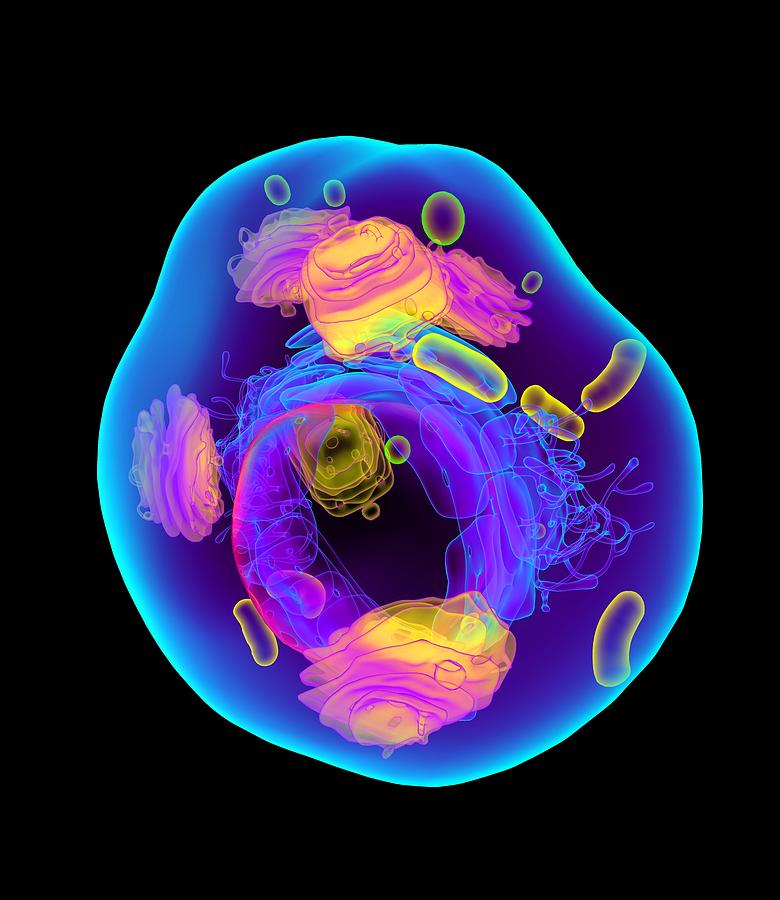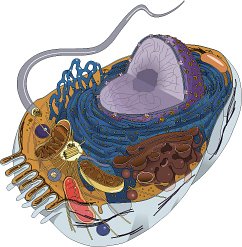Animal Cell Pictures Biography
Source:- Google.com.pk
Mitosis is the name for the kind of cell division that produces a greater number of cells = cell multiplication; after division, the daughter cells are about half the size of their parent, and they grow before division occurs again. A cell divides into two daughter cells tht are genetically identical to the original cell and to each other. Cells multiply to make an organism bigger, to repair damage, or to multiply the number of organisms of that kind.
The cell cycle refers to the continuing series of divisions alternating with cell growth: interphase—mitosis—interphase—mitosis—interphase. An acronym for the cell cycle is ...IPMATIPMATIPMATI... Most of the time a cell is in interphase, the growth and preparation stage of the cycle.
Mitosis, the actual process of dividing has four defined phases: Prophase, Metaphase, Anaphase, and Telophase; then the daughter cells enter interphase. Mitosis is a continuous process, and the phases blend into one another; it can often be hard to tell if an image is in the late part of one phase or the early part of another. We see them shown in books as snapshots of a particular instant in the process; you have to judge what was happening “when the music stopped.”
Note: Plant cells are often shaped like boxes because they are surrounded by a cell wall; at the end of mitosis, the cell plate divides the two daughter cells. Animal cells take a variety of different shapes; at the end of mitosis, a neck forms to separate the two daughter cells.
Slides—PHASES OF THE CELL CYCLE:
PLANT CELL DIVISION—root meristem of Allium cepa, the garden onion
root tip
Allium root tip:
Examine the square cells just inside the root cap. This is the root meristem (embryonic tissue) where mitosis is occurring. Farther up the root is the elongation zone, where cells are long rectangles; these cells are not undergoing mitosis.
INTERPHASE
interphase The nucleus of the cell is clearly stained and appears to have tiny dots and one or more dark nucleoli inside. What you can't see are the phases of interphase:
G1: Period of cell growth before (G = gap); ribosomes and organelles are being duplicated.
S: DNA replication (S = synthesis; new copies of DNA are synthesized.
G2: DNA has been replicated; cell is preparing for mitosis.
MITOSIS
prophase early
prophase later
Prophase:
Chromosomes become visible and nucleoli disappear (DNA + associated proteins become tightly organized).
Chromosomes consist of two sister chromatids (DNA replicas + associated proteins) attached together at a specialized region called the centromere.
Nuclear membrane breaks down and the chromosomes spread out.
Spindle fibers (microtubules) appear. They radiate out to the plasma membrane at the poles in animal cells. These radiations, called asters, are absent in plant cells.
metaphase
Metaphase:
The chromosomes assemble on the equatorial plate (an imaginary disc that crosses the center of the 3-dimensional cell). Some part of each chromosome is on this plate. Metaphase ends when the centromeres of each pair of chromatids split apart.
anaphase early
anaphase mid
Anaphase:
Sister chromatids separate from each other and move to opposite poles of the cell. The kinetochore, a part of the centromere of each new chromosome, moves along a spindle fiber. The free ends of each chromosome trail back toward the equatorial plate and indicate movement.
anaphase late
telophase
Telophase & Cytokinesis:
This is like the reverse of prophase—the cell is returning to interphase. Chromosomes (now single molecules of DNA with associated proteins) have reached opposite poles of the cell. Spindle fibers disappear. Nuclear membrane forms around the chromosome clusters. Chromosomes disappear from view as DNA re-extends, and nucleoli appear. The cell divides into two daughter cells (cytokinesis). In plant cells vesicles deposit new cell wall material along the equator to form the cell plate.
INTERPHASE: Daughter cells grow in size and prepare for renewed mitosis.
ANIMAL CELL DIVISION—Embryonic blastula stage of whitefish
whitefish blastula
Whitefish blastula:
The developing embryo of any organism is a good tissue to examine for mitosis, since cells must divide at a high rate to transform a fertilized egg (single cell) into the trillions of cells of a viable organism.
INTERPHASE
interphase Chromosomes are extended and not visible; regions where rRNA is being transcribed stain dark and are termed nucleoli.
MITOSIS
prophase
Prophase:
Replicated chromosomes, consisting of two sister chromatids held together at the centromere, have condensed and can be seen as stained bodies (chromo-somes).
metaphase
Metaphase:
Some part of every chromosome lies inside the equatorial zone.
anaphase
Anaphase:
Sister chromatids have separated from each other, and they, as new chromosomes, are moving to opposite poles of the cell.
telophase
Telophase & Cytokinesis:
Chromosomes have arrived at opposite poles of the cell, and cells are pinching off from each other (cytokinesis); compare this with cell plate formation in plant, above.
INTERPHASE
cytokinesis Daughter cells are returning to interphase.
Animal Cell Pictures Animal Cell Model Diagram Project Parts Structure Labeled Coloring and Plant Cell Organelles Cake


Animal Cell Pictures Animal Cell Model Diagram Project Parts Structure Labeled Coloring and Plant Cell Organelles Cake


Animal Cell Pictures Animal Cell Model Diagram Project Parts Structure Labeled Coloring and Plant Cell Organelles Cake


Animal Cell Pictures Animal Cell Model Diagram Project Parts Structure Labeled Coloring and Plant Cell Organelles Cake


Animal Cell Pictures Animal Cell Model Diagram Project Parts Structure Labeled Coloring and Plant Cell Organelles Cake


Animal Cell Pictures Animal Cell Model Diagram Project Parts Structure Labeled Coloring and Plant Cell Organelles Cake


Animal Cell Pictures Animal Cell Model Diagram Project Parts Structure Labeled Coloring and Plant Cell Organelles Cake


Animal Cell Pictures Animal Cell Model Diagram Project Parts Structure Labeled Coloring and Plant Cell Organelles Cake


Animal Cell Pictures Animal Cell Model Diagram Project Parts Structure Labeled Coloring and Plant Cell Organelles Cake


Animal Cell Pictures Animal Cell Model Diagram Project Parts Structure Labeled Coloring and Plant Cell Organelles Cake


Animal Cell Pictures Animal Cell Model Diagram Project Parts Structure Labeled Coloring and Plant Cell Organelles Cake
No comments:
Post a Comment